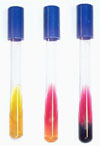The bacteria quickly metabolized the glucose, producing an acid slant and an acid butt (acid over acid; A/A) in a few hours. The Emben-Meyerhof-Parnas pathway is used both aerobically (on the slant) and anerobically (in the butt) to produce ATP and pyruvate. On the slant, the pyruvate is further metabolized to CO2, H2O, and energy. After further incubation (18 hours) the glucose was consumed, and then the bacteria utilized lactose and/or sucrose, maintaining an acid slant. The results are recorded as acid over acid (A/A). If the medium were incubated longer, over 48 hours, the lactose and sucrose would be depleted, and the slant would revert to an alkaline pH due to metabolism of the peptones. In the anerobic butt, the bacteria convert pyruvate into stable acid endproducts, thus the butt remains acidic.
The black precipitate indicates that the bacteria were able to produce hydrogen sulfide (H2S) from sodium thiosulfate. Because H2S is colorless, ferric ammonium citrate is used as an indicator resulting in the formation of insoluble ferrous sulfide. Formation of H2S requires an acidic environment; even though a yellow butt cannot be seen because of the black precipitate, the butt is acidic. The results would be recorded as acid over acid (A/A), H2S positive.
Bacteria commonly producing an A/A with H2S include: Citrobacter freundii*, Proteus mirabilis*, and P. vulgaris*.
* = variable reactions
Reference: MacFaddin, J.F. (2000) Biochemical Tests for Identificaion of Medical Bacteria, 3rd. ed. Lippincott Williams & Wilkins, Philadelphia. |

